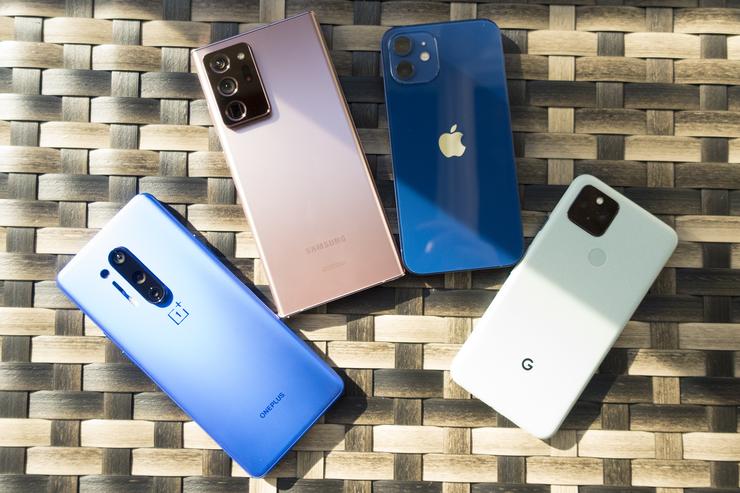 Credit: Michael Simon/IDG
Credit: Michael Simon/IDG
Along with the rest of 2020, it’s been a wild and unpredictable year for smartphones. Samsung started the year by shipping its most expensive phone ever and finished with one of its best bargains. Google dropped its flagship Pixel to the mid-range and delivered its best design ever, while a OnePlus phone topped a grand for the first time. Apple shipped its smallest phone since the iPhone 5. And everything came with 5G on board.
Which phone emerged from the chaos as the champion of 2020?
The phones
Samsung Galaxy Note 20 Ultra: The Galaxy Note 20 Ultra is Samsung’s best phone to date even if it has a slightly inferior camera and smaller battery than the S20 Ultra.
OnePlus 8 Pro: OnePlus went all out on its phones this year, attacking both the high end and the low end with more models than ever before. Even with the 8T arriving months later, the 8 Pro is my pick of the litter, especially at its newly reduced price tag.
Google Pixel 5: Google did an about-face with its smartphones this year, but the Pixel 5 is still among the best Android phone, thanks to Android 11.
iPhone 12: You can make an argument that the $999 iPhone 12 Pro is worth the extra money, but unless you’re taking a lot of zoomed shots, the iPhone 12 is the sweet spot.
Note: The Android phones here represent the best in North America. That means Huawei, which continues to innovate with its camera and speed, and Xiaomi, which had an impressive entry with the Mi 10 Ultra, are out of the running.
iPhone vs Android: Design
The phones here might not fold or swivel, but that doesn’t mean they don’t each have their own unique identities. Their respective wheels most certainly haven’t been reinvented, but each phone has enough little touches to both separate it from the others and raise it above the rest of the pack.
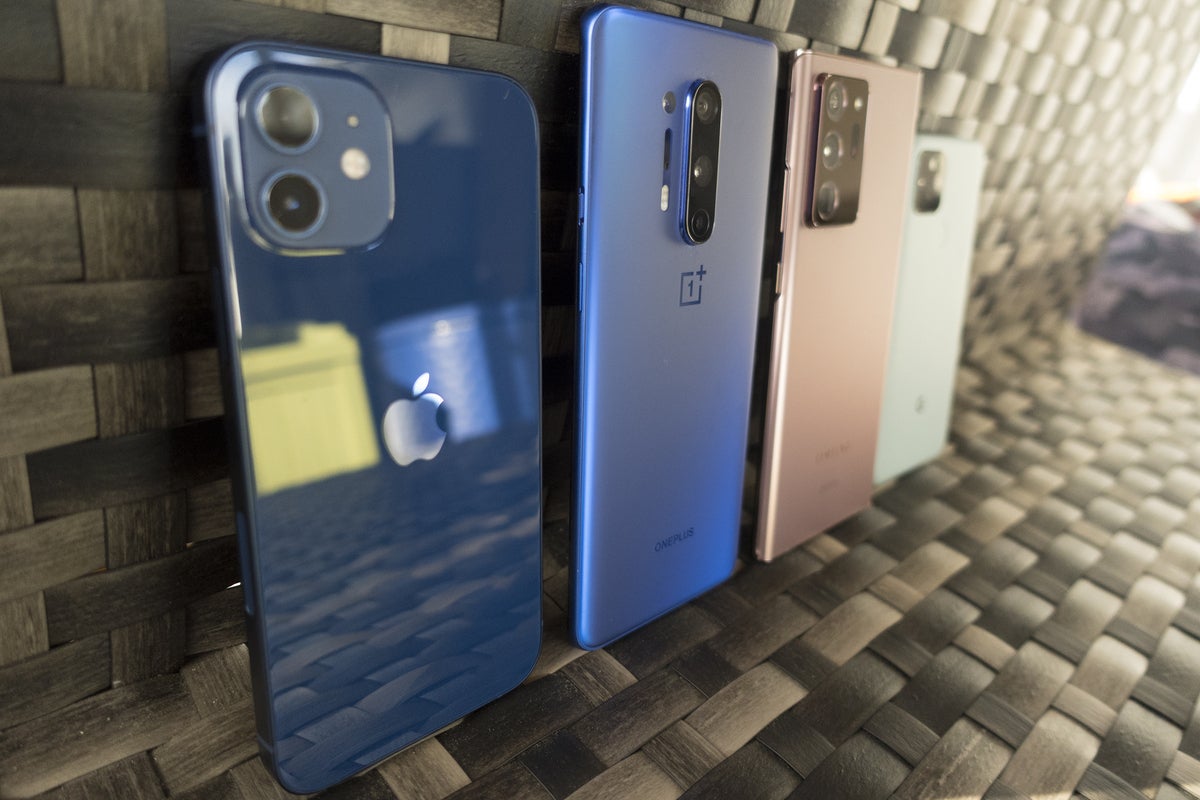 Michael Simon/IDG
Michael Simon/IDG
The iPhone 12, far left, has a gorgeous design.
First, let’s look at the size and screen proportions.
Dimensions (listed from largest to smallest)
Note 20 Ultra: 164.8 x 77.2 x 8.1mm
OnePlus 8 Pro: 165.3 x 74.3 x 8.5mm
iPhone 12: 146.7 x 71.5 x 7.4mm
Pixel 5: 144.7 x 70.4 x 8.0mm
Screen to body ratio (listed from highest to lowest)
Note 20 Ultra: 91.63%
OnePlus 8 Pro: 90.79%
iPhone 12: 87.45%
Pixel 5: 86.75%
The Note 20 Ultra is unmistakably Samsung, with a giant curved Infinity display, hole-punch selfie cam, and very skinny bezels above and below the screen. Like previous Notes, it has a very squared-off aesthetic that makes it seem much taller than it is, while the camera bump in the left corner is quite a bit large and way more bulbous than the other phones here.
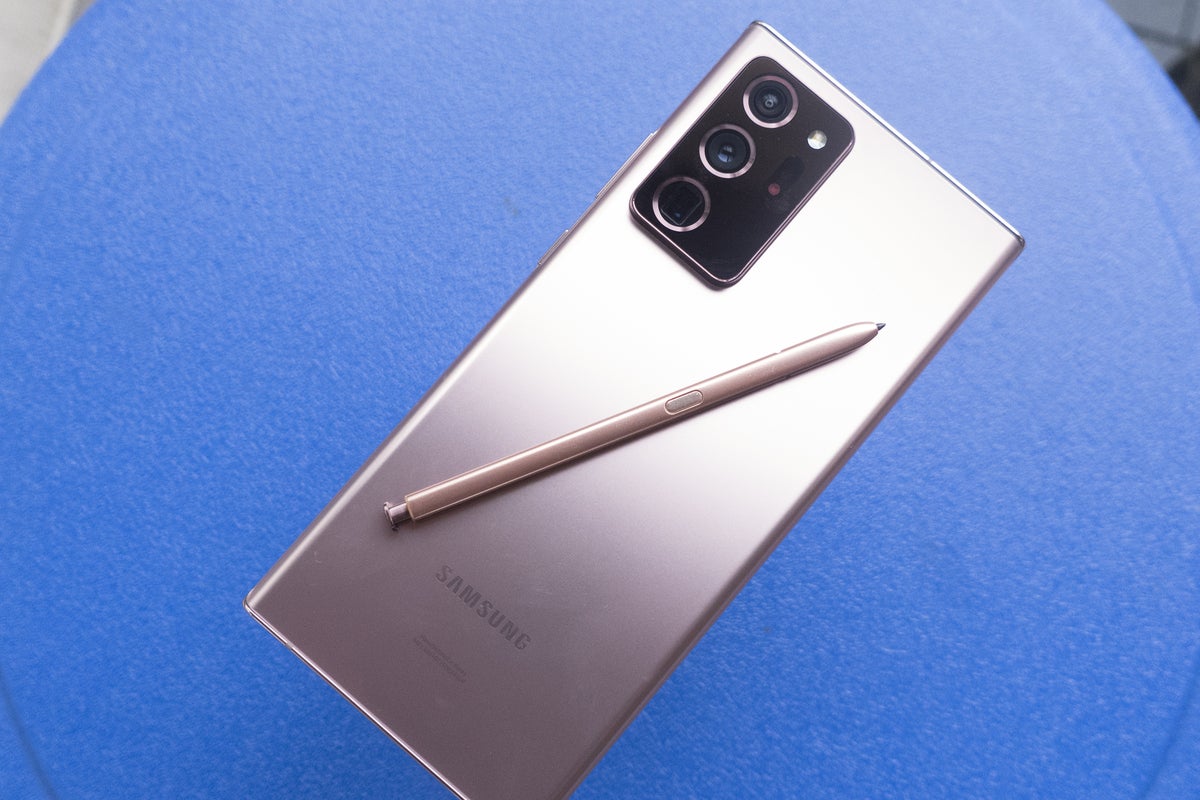 Michael Simon/IDG
Michael Simon/IDG
The Note 20 Ultra looks pretty in Mystic Bronze.
The best color is the new matte Mystic Bronze that’s a cross between gold and rose gold. But you’ll probably want to put it in a case. For one it’s it’s made entirely of glass, and for another, its size makes it tricky to hold even with two hands. The squared corners, flat bottom, and camera bump look good, but they combine to create a very awkward and clumsy grip. It’s also extremely heavy compared to the other phones here.
Weight (listed from heaviest to lightest)
Note 20 Ultra: 208g
OnePlus 8 Pro: 199g
iPhone 12: 164g
Pixel 5: 151g
The Pixel 5 isn’t just the lightest in this group, it’s also one of the nicest. Google did a great job with its latest Pixel phone, delivering the first design that doesn’t have enormous bezels. In fact, it’s the only Android phone that I’m aware of that has universal bezels all around, giving the Pixel 5 a balanced, symmetrical aesthetic similar to the iPhone 12.
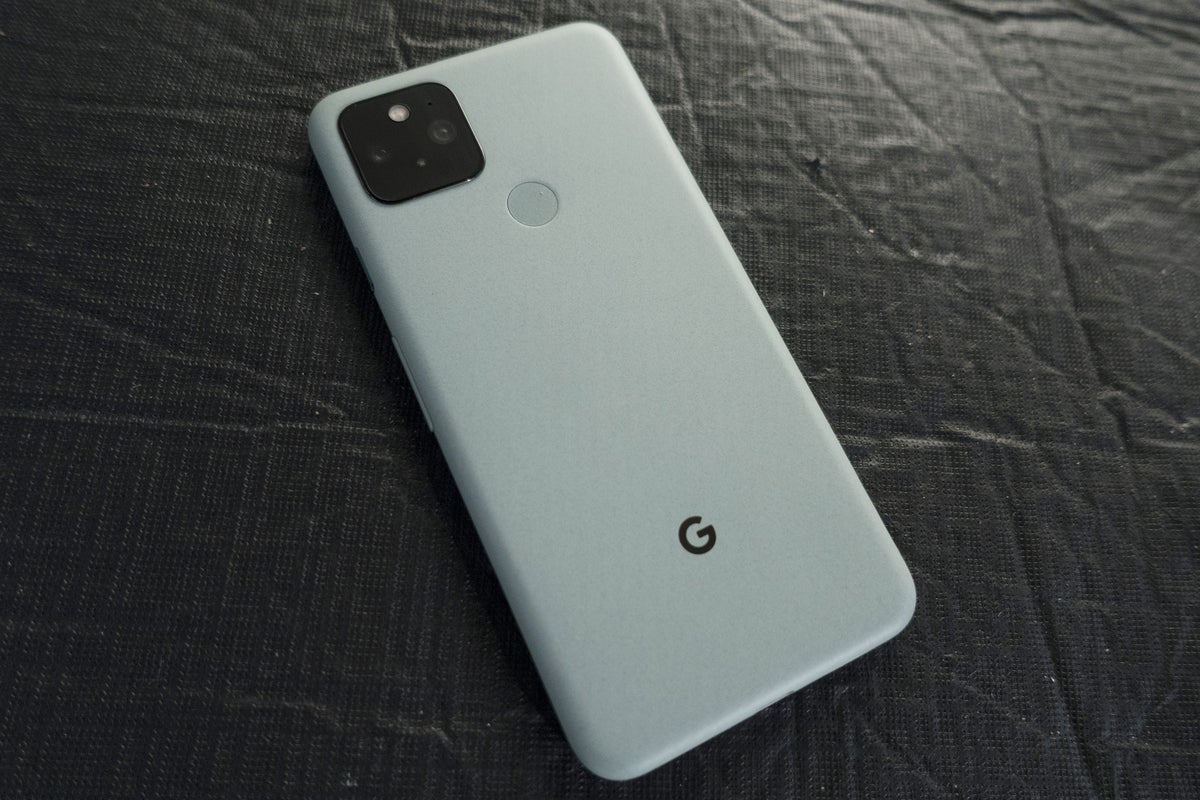 Michael Simon/IDG
Michael Simon/IDG
The Google Pixel 5 has another offbeat color: Sorta Sage.
Otherwise, it’s very much a Pixel. The silhouette is the same as it’s been since the original model, and the square camera array is very much cribbed from the Pixel 4. With very little bezel, the selfie cam is in the left-hand corner of the screen and mostly tucked out of sight.
Read more
iPhone 11 vs Android’s best at PCWorld
OnePlus 8 Pro review at PCWorld
Galaxy Note 20 Ultra review at PCWorld
The Pixel 5 is the only phone here that isn’t made of glass, but it’s not quite aluminum either. The back is covered in a plastic bio-resin that gives the phone a strange texture and a less-than-premium feel. The Sorta Sage color is nice though and the chrome-wrapped power bottom is a nice touch.
The OnePlus 8 Pro is probably the least recognizable of the group, but that’s not to say it’s a plain or boring phone. It has a fantastic curved display and is the only phone in this bunch that doesn’t have a distractingly large camera array. The corners of the display perfectly match the phone’s shape, and the bezels above and below the screen are extremely skinny, giving it a near edge-to-edge aesthetic that feels great to hold.
 Michael Simon/IDG
Michael Simon/IDG
The OnePlus 8 Pro Ultramarine Blue color is a beauty in its own right.
The back is made of glass but it’s frosted so it doesn’t pick up fingerprints as easily as the Note 20 and iPhone 12. The two new colors, Glacial Green (8GB RAM) and Ultramarine Blue (12GB RAM), wrap around the sides of the display and look fantastic.
At first glance, the iPhone 12 looks a lot like the iPhone 11 it replaces, but the subtle changes Apple has made are meaningful. The most obvious is the bezel size. On the iPhone 11, bezels were quite large at 5.57mm all around, but on the iPhone 12, they’re just 3.47mm. The iPhone 12 is also thinner and lighter than the iPhone 11, and since Apple has returned to a “flat” design for the sides and the screen, the phone has an aesthetic that looks and feels even smaller than it is.
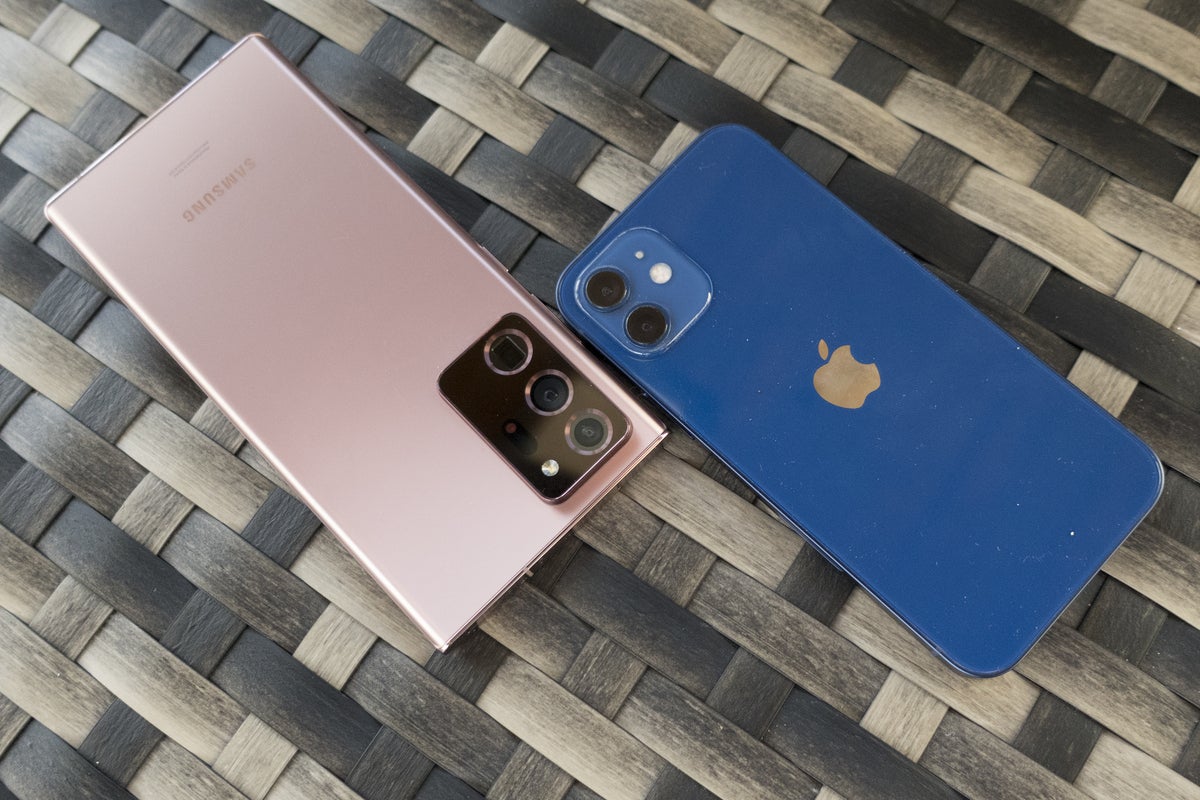 Michael Simon/IDG
Michael Simon/IDG
You don’t even need to snap a pic to see that the Note 20 Ultra’s camera array is more powerful than the iPhone 12’s.
It’s also a lot lighter than the other all-glass phones here. Granted, it has a smaller screen than the Note 20 and OnePlus 8 Pro, but the difference in both weight and distribution is palpable when you’re holding it. By contrast, the Note 20 is very top heavy and while the Pixel 5 is significantly lighter, feeling less like a premium phone and more like a plastic budget one. The iPhone 12 strikes a nice balance between balance and build quality.
The rather large notch remains as does the attention-grabbing camera array, but the iPhone 12’s overall design is the nicest Apple has produced in years. It’s solid, symmetrical, and stylish, and easily stands out in a crowded field of rounded rectangles. As phones become homogenous with giant screens and cameras, Apple continues to find a way to lead the way with smart iterations and character.
Our pick: iPhone 12
iPhone vs Android: Display
Premium smartphone displays have reached the point where they basically all get A+ ratings from DisplayMate, so no matter which phone you get, you’re getting one of the best displays ever made.
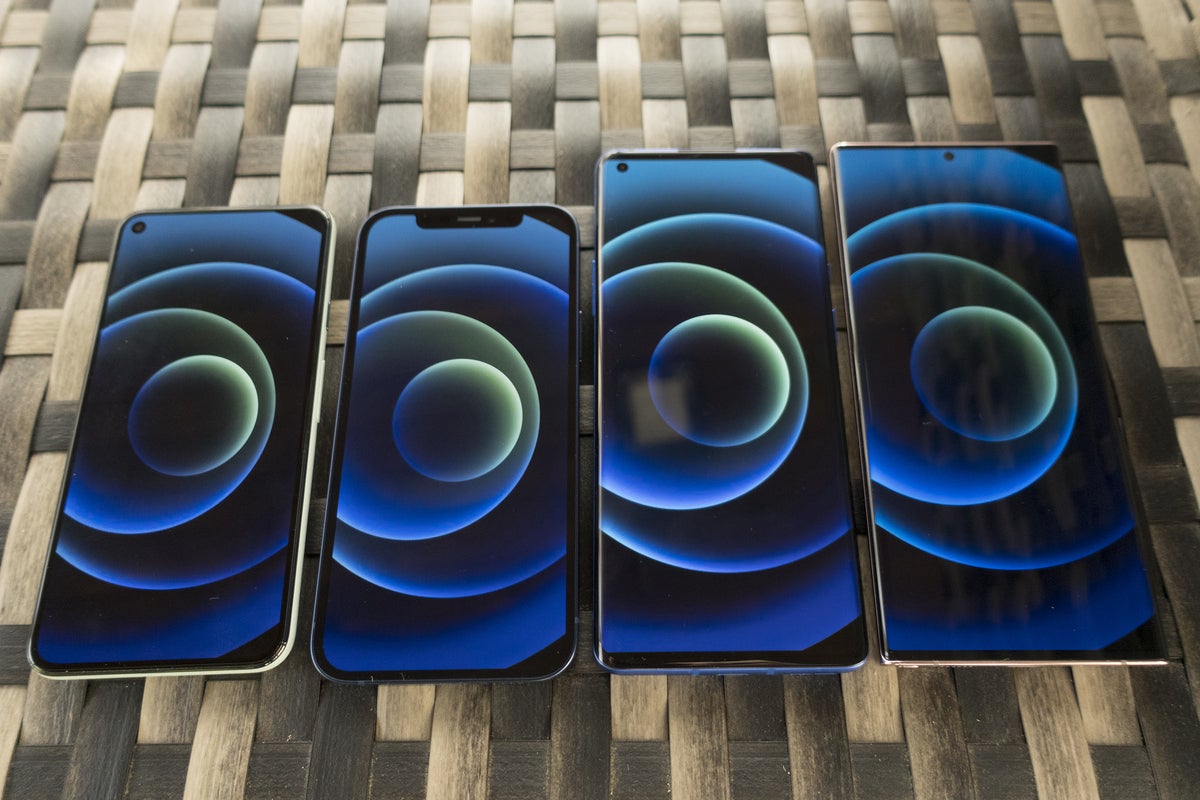 Michael Simon/IDG
Michael Simon/IDG
The phones here have different sized screens but all of them are stunning.
Before we get into size, brightness, and and pixel density, the main difference between the Android phones and the iPhone 12 is display speed. While the iPhone 12 is stuck at 60Hz, the Pixel 5 operates at 90Hz, and the Note 20 Ultra and 8 Pro have 120Hz refresh rates. Higher refresh rates mean scrolling should be faster and gaming and videos smoother on those phones, especially when you switch between 60Hz and 120Hz on the Note 20 Ultra and OnePlus 8T. But Apple does such a tremendous job with its display calibration and OS optimization that the iPhone 12 doesn’t feel noticeably slower than the 120Hz phones.
The same goes for the resolution. The iPhone 12 and the Pixel 5 both have Full HD+ 1080p displays while the Note 20 Ultra and OnePlus 8 Pro have Quad HD+ 1440p displays. (One caveat, however: you need to lower the Note 20 Ultra’s resolution to 1080p to use the 120Hz refresh rate.) The difference is negligible. While the Pixel 5 has separate issues with color saturation and brightness, both displays are as crisp and pixel-dense as the QHD displays, and the iPhone 5 is every bit as rich and vibrant. If I didn’t see the spec sheet, I’d never know the iPhone 12 has fewer pixels.
Apple might not have changed the resolution for its “Super Retina XDR display,” but it did add a small change that elevates it even further above the other phones here. Apple calls it Ceramic Shield and it’s designed to keep your phone’s screen from cracks when dropped from a high distance. I thankfully didn’t have a chance to test that, but after a month of use without a screen protector, I couldn’t see any micro scratches on my phone’s screen like on other phones, including the most recent iPhones.
While all of the phones here fall into the “large” category, there’s nearly an inch between the smallest and the largest. That might not seem like much on paper, but it makes a huge difference when using them.
Screen size (listed from smallest to largest)
Pixel 5: 6-inch
iPhone 12: 6.1-inch
OnePlus 8 Pro: 6.78-inch
Note 20 Ultra: 6.9-inch
The Galaxy Note 20 Ultra isn’t just the biggest among the phones here, it’s one of the nicest displays I’ve ever used. Colors are vibrant without being too saturated, photos are rich and bright (with a peak that touched 1,600 nits), and videos are dynamic and smooth. It’s hard to find a complaint, except perhaps it’s a bit too big.
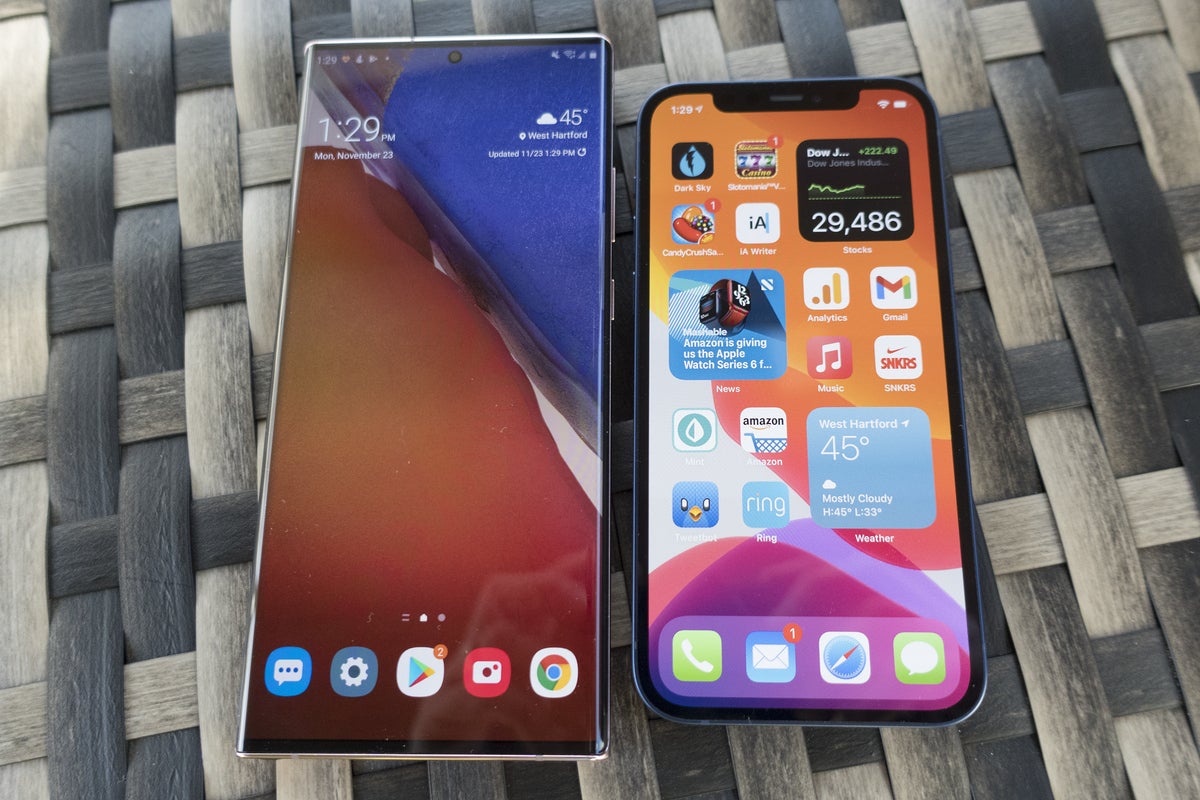 Michael Simon/IDG
Michael Simon/IDG
The Galaxy Note 20 Ultra (left) has a stunning 120Hz display.
The said, the OnePlus 8 Pro isn’t all that smaller than the Note 20 and it, too, is visually stunning. Like the Note 20, the sides are curved, and its Quad HD+ 3168 x 1440 is bright and vivid. It’s bright and crisp, but I found the white balance to be a bit off at times and I noticed a slight purple tint when compared to the other displays.
And as I said above, the iPhone 12’s display is remarkable as well. But for speed, clarity, brightness, and depth, the Galaxy Note 20 Ultra stands alone. Even with 1080p resolution, Apple is very close to the Note 20 Ultra, and if the iPhone 13 gains a 120Hz ProMotion display as rumored, it will more than likely catch up.
Our pick: Galaxy Note 20 Ultra
Next page: Performance, battery life, and OS comparisons

















